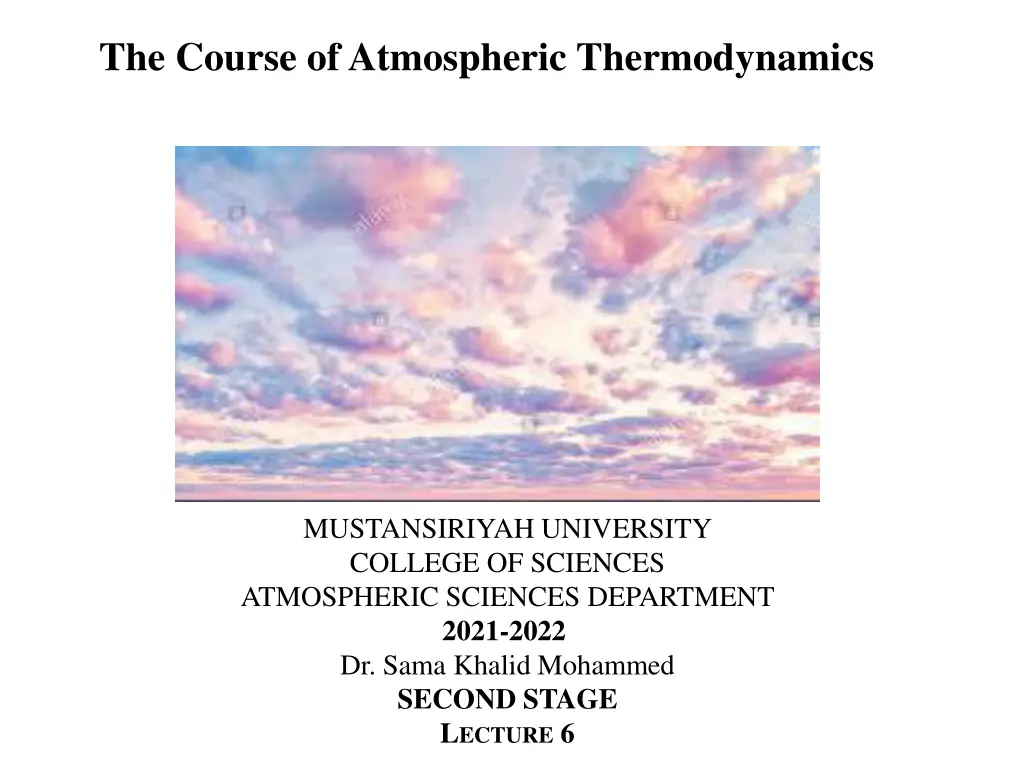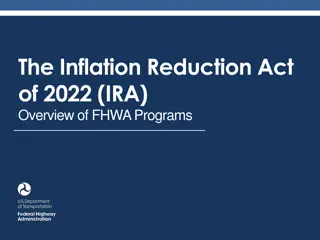
Understanding Phase Change in Atmospheric Thermodynamics
Explore the concept of phase change in atmospheric thermodynamics, including the transitions between solid, liquid, and vapor states, the critical point, and unique characteristics of water's phases. Discover how heat energy is involved in these transformations and the impact on the environment.
Download Presentation

Please find below an Image/Link to download the presentation.
The content on the website is provided AS IS for your information and personal use only. It may not be sold, licensed, or shared on other websites without obtaining consent from the author. If you encounter any issues during the download, it is possible that the publisher has removed the file from their server.
You are allowed to download the files provided on this website for personal or commercial use, subject to the condition that they are used lawfully. All files are the property of their respective owners.
The content on the website is provided AS IS for your information and personal use only. It may not be sold, licensed, or shared on other websites without obtaining consent from the author.
E N D
Presentation Transcript
The Course of Atmospheric Thermodynamics MUSTANSIRIYAH UNIVERSITY COLLEGE OF SCIENCES ATMOSPHERIC SCIENCES DEPARTMENT 2021-2022 Dr. Sama Khalid Mohammed SECOND STAGE LECTURE 6
THIS LECTURE INCLUDING THE FOLLOWING ITEMS Phase Change Recall some terms that we learned in the first course of Fundamentals of Thermodynamics Entropy
PHASE CHANGE Water vapor is an invisible gas that becomes visible when it changes into larger liquid or solid (ice) particles. This process of transformation is known as a change of state or, simply, a phase change. The heat energy required to change a substance, such as water, from one state to another is called latent heat. But why is this heat referred to as latent ?
PHASE CHANGE A phase change is a change between solid, liquid, or vapor (gas). A system may even have more than one solid or liquid phase such as Carbon with two solid phases (graphite & diamond). The phase of a system in equilibrium can be represented on a phase diagram. The lines separating the phases represent where the two phases can coexist. The triple point represents the one and only point on the diagram where all three phases can coexist. points
PHASE CHANGE The critical point occurs at the end of the vapor-to-liquid transition line. At temperatures above the critical temperature, or pressures above the critical pressure there is no distinction between the liquid and vapor phases. The slope of the solid-to- liquid transition line shows how the melting point changes with pressure. An increase in pressure will increase the melting point.
PHASE CHANGE Water is one of the few substances that can exist in all three phases at the temperatures and pressures found in the Earth s atmosphere. The triple point of water is at 0.01 C and 6.03x10-3 atm (611 Pa). A unique feature of water is that the solid-to-liquid transition line slopes upward to the left, instead of to the right.
PHASE CHANGE When the change of state is from left to right, heat is absorbed by the substance and taken away from the environment. The processes of melting, evaporation, and sublimation (ice to vapor) all cool the environment.
PHASE CHANGE When the change of state is from right to left, heat energy is given up by the substance and added to the environment. The processes of freezing, condensation, and deposition (vapor to ice) all warm their surroundings.
Latent heat is an important source of atmospheric energy, why ?????? Once vapor molecules become separated from the earth s surface, they are swept away by the wind rising to high altitudes where the air is cold, the vapor changes into liquid and ice cloud particles. During these processes, a huge amount of heat energy is released into the environment. Water vapor evaporated from warm, tropical water can be carried into polar regions, where it condenses and gives up its heat energy. Thus, evaporation-transportation-condensation is an extremely important mechanism for the relocation of heat energy (as well as water) in the atmosphere.
FYI: A REVIEW OF STATE VARIABLES The state of a system is defined by the position and momentum of every piece of matter in the system. o For a cubic meter of air at sea level this requires the knowledge of the position and momentum of every 2.56x1025 molecules in the volume! It is impossible to measure or know the state of the system as defined above. Therefore, we content ourselves with knowing something about the average or macroscopic properties of the system as a whole. This is what the subject of thermodynamics attempts to do.
FYI: A REVIEW OF STATE VARIABLES In general: o For a one-component system in equilibrium we need 3 state variables. o For a two-component system in equilibrium we need 4 state variables. o For a three-component system in equilibrium we need 5 state variables. o For a j-component system in equilibrium we need j + 2 state variables.
A REVIEW OF STATE VARIABLES The thermodynamic state of a simple system in thermodynamic equilibrium is completely characterized by specifying the internal energy (U), volume (V), and the number of moles, ni, of each of its components. As an example of a simple versus a non-simple (complex) system, imagine two systems: System A is a mixture of two ideal gasses in a rigid container of volume V at a temperature T and pressure p. This is a simple system whose thermodynamic state is given by the total internal energy U, the total volume V, and the number of moles of the two gasses, n1 and n2.
A REVIEW OF STATE VARIABLES If we take the same two gasses and separate them into separate compartments of the total system, and keep each gas at the same temperature and pressure as the previous simple system, the total internal energy U and total volume V of this system are the same as that of the simple system. However, the thermodynamic states are not the same. We will find out later that the entropy, S, of the complex system is lower than the simple system. So, we need an additional thermodynamic state variable to completely characterize the state of the complex system.
A REVIEW OF STATE VARIABLES As we said, the thermodynamic state of a one-component, closed system in equilibrium can be completely described by any two state variables (other than mass or moles). The state variables have two important properties: The change in any of the state variables (say U) doesn t depend on the path of the system on a thermodynamic diagram. It only depends on the endpoints.
A REVIEW OF STATE VARIABLES Mathematically, this means that differentials of state functions are exact differentials. Here the problem is going to appear, because HEAT & WORK is not a state variables !!!!!! But Heat and work are modes of transfer of energy, thus how can we deal with them to know about the state of thermodynamic System ???
A REVIEW OF STATE VARIABLES We know why work is not a state variable, but what about heat ???? Imagine that an air parcel starts out at Point 1 on the skew-T diagram shown below. The initial pressure and temperature are p1 and T1. The parcel moves in a reversible, closed cycle around the path shown. The three legs of the path are: Leg A: Adiabatic expansion to pressure p2. Leg B: Isothermal compression back to pressure p1. Leg C: Isobaric heating back to temperature T1. https://www.weather.gov/jetstream/skewt
Leg A: Adiabatic expansion to pressure p2. Leg B: Isothermal compression back to pressure p1. Leg C: Isobaric heating back to temperature T1. isobar isotherm dry adiabat saturated adiabat A B saturation mixing ratio C
A REVIEW OF STATE VARIABLES Thus, the total heat around the closed, reversible path is not zero. Therefore, heat is not a state variable.
The Fundamental Equation and Entropy PAY ATTENTION WHY WE DIVIDED BY T ???
What are the thermodynamic definition of temperature & pressure using Entropy and 1st law of thermodynamics???
What are the thermodynamic definition of temperature & pressure using Entropy and 1st law of thermodynamics???






















